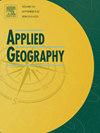Spatial heterogeneity analysis and driving forces exploring of floating population in China's central and western regions:A case of henan province, China
IF 4
2区 地球科学
Q1 GEOGRAPHY
引用次数: 0
Abstract
Floating populations exhibit specific characteristics and regional disparities during different geographical regions and periods, significantly impacting the China's urbanization process. Within the context of the gradual normalization of population migration and the return of population from the central and western region, a systematic study of the spatial distribution and the influencing factors of floating population is necessary. As a typical province of central and western regions of China, this study examined spatial heterogeneity of influencing factors using spatial correlation and Geographically Weighted Regression (GWR) modelling in county-level cities within Henan province in 2010 and 2020. This study found, from 2010 to 2020, floating populations showed significant spatial deviations and a trend of accelerated concentration in central cities. The hotspots were spatially agglomerated in Zhengzhou Metropolitan Circle, while the coldspots were concentrated in southeastern Henan province. The impact of market regulation and public service levels on the spatial patterns of the floating population has gradually strengthened, the influence of government regulation has gradually weakened. The degree of impact of each explanatory variable on floating population distribution varies across regions in Henan Province. This study provides references to formulate targeted governance policies for the floating population in central and western regions of China.
求助全文
约1分钟内获得全文
求助全文
来源期刊

Applied Geography
GEOGRAPHY-
CiteScore
8.00
自引率
2.00%
发文量
134
期刊介绍:
Applied Geography is a journal devoted to the publication of research which utilizes geographic approaches (human, physical, nature-society and GIScience) to resolve human problems that have a spatial dimension. These problems may be related to the assessment, management and allocation of the world physical and/or human resources. The underlying rationale of the journal is that only through a clear understanding of the relevant societal, physical, and coupled natural-humans systems can we resolve such problems. Papers are invited on any theme involving the application of geographical theory and methodology in the resolution of human problems.
 求助内容:
求助内容: 应助结果提醒方式:
应助结果提醒方式:


